Abstract
This article seeks to compare the performance of a LIDAR Windcube V2, manufactured by Leosphere, with that of a SODAR MFAS, manufactured by Scintec, in evaluating wind speed at different altitudes. The data from these two sensors were collected at three locations on the Brazilian equatorial margin in the state of Maranhão. The comparison of these sensors aims at their simultaneous use at different points. The horizontal velocity components, by altitude, showed Pearson correlation values above 0.9 and values for the vertical velocity component between 0.7 and 0.85. As for the sampling efficiency, the LIDAR had a performance slightly higher than that of SODAR, especially at the point closest to the coast. In general, both sensors showed similar values, despite the differences in sampling methods. The results showed that the joint performance of these sensors had good correlation, being reliable for application in estimating wind potential for power generation in coastal areas of the equatorial region.
1. Introduction
A project is in progress in the state of Maranhão, Brazil to map the potential for electricity generation by using wind as one of the primary sources. Its main objective is to evaluate wind and solar resources using in situ observational data, remote sensing data, and atmospheric reanalysis [1]. To obtain information on wind energy at low levels, two wind estimation systems were acquired based on remote sensing techniques: Light Detection and Ranging (LIDAR) which uses electromagnetic waves [2], and Sound Detection and Ranging (SODAR) [3], which probes the atmosphere with sound waves [4,5]. The comparison of these sensors is significant due to their employment in different locations within the project’s study area. Its estimated or “measured” parameters describe the air movement from the information of the wind’s direction, orientation, and intensity, as well as the statistics produced based on the sampling techniques of each sensor. Obtaining these parameters basically depends on the physics of the propagation of electromagnetic and acoustic waves [2,3,6,7,8,9,10,11,12,13].
Renewable energies, especially wind, are playing a leading role in the process of decarbonization of the electric matrix, as well as in the green hydrogen generation chain. The equatorial margin of the north-northeast region of Brazil presents advantageous natural conditions for wind energy production both on shore and off shore. Key components to this very favorable scenario are the trade winds that are characteristic of the equatorial region and occur regularly throughout all months of the year.
As a consequence, many initiatives that aim to deepen the knowledge of and better characterize this region are being carried out, while others are on course. In this way, new technologies for measuring wind potential have evolved significantly in recent years, where the LIDAR and SODAR profiling devices stand out. These devices have gained ground in measurement campaigns in wind farms worldwide, and some papers reported on their performance individually and comparatively [3,9,11,14,15]. However, no experimental validation research was performed under typical equatorial conditions (e.g., with high temperatures, humidity gradients, and peculiar relief and vegetation).
In this paper, we present an experimental study on the comparative performance of these two types of profilers at three locations on the Brazilian equatorial margin in the state of Maranhão. This research is part of the Evaluation of the micrometeorological effects in different temporal and spatial scales in the planning and operation of wind farms and photovoltaics (EOSOLAR) project, which made the field activities for this work possible. Here, we briefly describe these locations, the climatology of the region, some characteristics of the sensors, and their sampling methodology. We present a methodology to compare these instruments and discuss aspects associated with the atmospheric boundary layer in the transition of the ocean to the continent.
2. Measurement Campaigns: Sites and Procedures
The measurements took place at three sites, all in the state of Maranhão. The first was on the campus of the Federal University of Maranhão (UFMA, São Luís, Brazil) in the city of São Luís, an urban and insular region ( point in Figure 1). The other two measurement campaigns were carried out in the town of Paulino Neves, located about 190 km east of São Luís, represented in Figure 1 by the points marked as and .
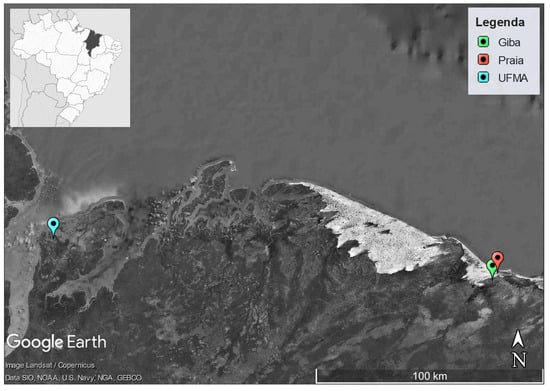
Figure 1.
Eastern coast of Maranhão state in Brazil, showing the positions of the (at UFMA’s Electric Energy Institute in the city of São Luís), , and (both in the city of Paulino Neves) campaigns.
During the first campaign, the devices were installed at UFMA’s Electric Energy Institute (IEE) at longitude 44.307° W and latitude 2.560° S. For safety, the LIDAR was installed on the roof of the IEE, about 3.5 m high, while the SODAR was maintained at ground level (Figure 2). This campaign refers to the longest comparison time between the devices, comprising 20 days in duration from 7 to 26 August 2021 (Table 1).

Figure 2.
campaign (IEE-UFMA, 44.307° W, 2.560° S). (upper) LIDAR wind profiler installed 3.5 m from the ground on the roof. (bottom) SODAR installed at ground level in the parking lot.

Table 1.
Periods, total days, locations of the instruments, and distances from the coastline during the measurement campaigns.
The second campaign was conducted near the beach at the point called , located at longitude 42.555° W and latitude 2.694° S, between 9 and 10 November 2021 (Table 1). The distance between the sea and this point was estimated to be 1300 m by Google satellite imagery. However, the beach has a low slope and is vulnerable to flooding during astronomical tides. Macro-tidal flooding occurs in this region, which causes high variations in the amplitude of the sea level [16] (Figure 3).
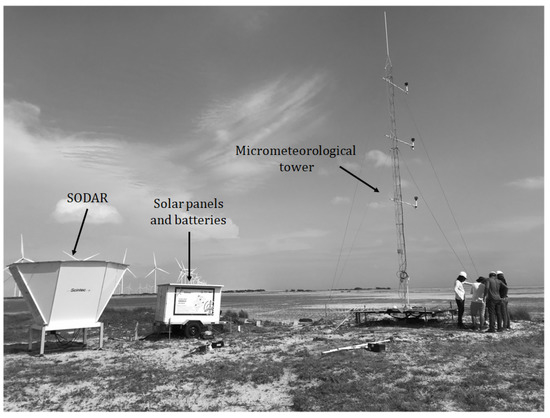
Figure 3.
campaign (42.555° W, 2.694° S), showing the SODAR and micrometeorological tower set-up. This point is located about 1300 m from the beach line and windward of the wind turbines of the Delta wind farm in Paulino Neves.
The last campaign was carried out at a point further from the coast on Mr. Gilberto Porto’s farm, called in this study, at longitude 42.575° W and latitude 2.725° S. It is a region with low dunes and a little slope, having low vegetation and bushes (Figure 4). At this site, the measurements were conducted between 10 and 12 November 2021.
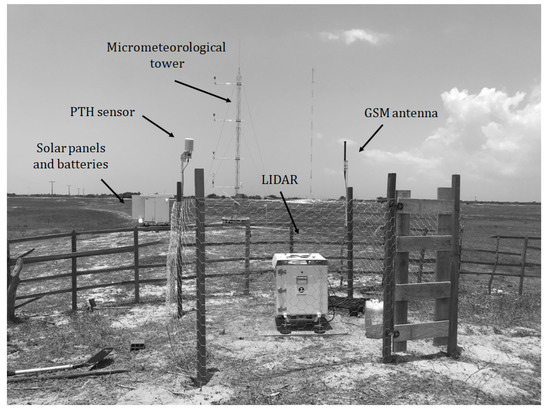
Figure 4.
campaign (−42.575° W, −2.725° S), showing the LIDAR installation. This point is located about 3.4 km from the point in a region with low vegetation and bushes.
3. Regional Climatology
The local weather patterns, and thus the generation of electricity based on the transformation of both the energy of the air motion and solar radiation, depend on the climatology in the region of study. The EOSOLAR project [1] will collect data over the course of a year, allowing us to understand the variability in wind and solar sources at different time and space scales. In the study region, climatology is governed mainly by local aspects dependent on topography, vegetation, proximity to the ocean, and latitude, which define the solar irradiation that reaches the ground. However, some large-scale spatial and temporal agents influence the local climate. Among them, we can mention the following:
- With intervals between 2 and 7 years, the atmospheric teleconnections El Niño and La Niña have impacts on global atmospheric circulation, with well-defined effects on various “climatic” patterns in Brazil, such as precipitation and wind circulation in the northeast [17,18,19,20,21,22,23,24,25,26,27,28,29,30];
- The intertropical convergence zone (ITCZ) and its seasonal periods define changes in cloud patterns, precipitation, wind direction, and intensity in the region [31,32,33,34,35,36,37,38];
- The seasonally periodic South American monsoon also influences local weather patterns [39,40,41,42,43,44,45];
- The effects of Madden–Julian oscillations with a periodicity between 40 and 50 days [46,47,48,49,50,51,52,53,54,55];
- The easterly waves, with a typical periodicity of 4 days [37,56,57,58,59,60,61];
- The sea and land breeze with daily cycles [62,63,64,65,66,67,68,69,70,71].
4. LIDAR and SODAR Wind Profilers
Wind profilers use different forms of energy to detect targets in air parcels and estimate motion from their transport with the Doppler-Fizeau effect [72]. The operating wavelength of our LIDAR (Windcube V2, manufactured by Leosphere) was 1543 nm [73], and that of our SODAR (MFAS, manufactured by Scintec) was to the order of 0.12–0.2 m [74] (i.e., seven orders of magnitude greater).
As for the targets of the sensors, SODAR detects deformations in the flow or inhomogeneities of the air density field, while LIDAR detects particles (aerosols) transported in the atmosphere. In both sensors, the return signal or backscatter of the targets is analyzed, and the radial velocity, also called the line of sight velocity, is estimated. The measurement of the radial velocity in different directions makes it possible to compose the wind velocity vector at different vertical levels.
The beam geometry and sampling windows of the return signals from these sensors are different. LIDAR emits four oblique beams in the north, south, east, and west directions at an angle of 28 from vertical and a vertical beam [75]. SODAR emits nine acoustic beams, with the main beam emitted vertically at 0 and eight beams in pairs of complementary pulses in opposite directions (from 29 to −22) in the north, east, south, and west directions (Figure 5).
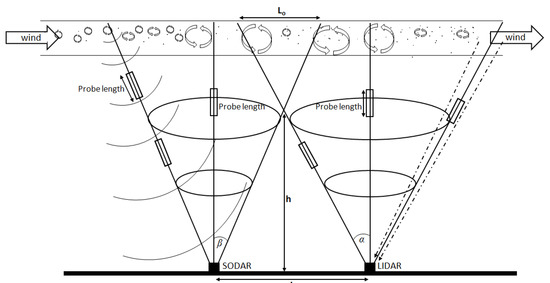
Figure 5.
Geometries of the beams emitted by LIDAR and SODAR for the campaign. LIDAR was positioned 3.5 m above the surface. and are the angles concerning the vertical beam emitted by LIDAR (28) and SODAR (from 29 to −22), respectively.
From temporal averages of the samples performed in the detected horizontal layers, the wind characteristics are estimated differently between both sensors. The frequencies of electromagnetic waves (LIDAR) and sound waves (SODAR) detect different structures (targets), so naturally, there will be differences in sensor performance depending on the environmental conditions. In this paper, the difference between the performances of these wind profilers will be shown.
Both devices were configured for measurements with intervals of 10 m from 50 to 200 m in height and 20 m from 200 to 280 m in height (Table 2). However, we emphasize that each device’s horizontal slab length was different. While the horizontal slab length of the SODAR was 10 m, that of the LIDAR was 20 m (Figure 6).

Table 2.
Height of measurements (m), linear overlap (m), sector length sampled by LIDAR and SODAR added together, and overlapping linear percentage sampled relative to total length (LIDAR + SODAR).
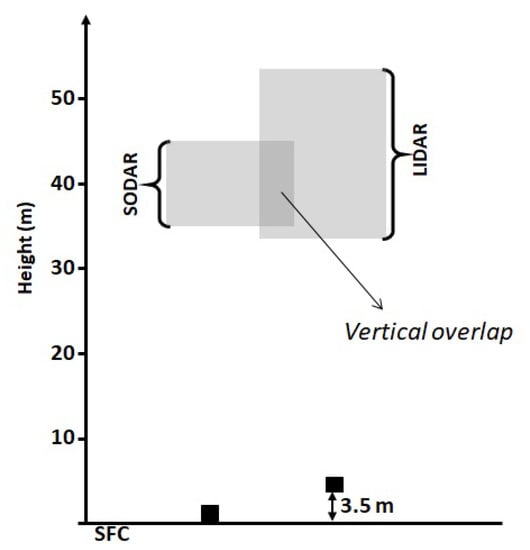
Therefore, the vertical overlap sampled was at least 10 m between the instruments. The calculation of the horizontal overlap will be demonstrated in the next section. Table 2 lists the coincident horizontal layers sampled by LIDAR and SODAR.
5. Methodology
To compare measurements of the parameters associated with wind speed obtained from SODAR and LIDAR, observing the basic principles that each technology uses in its estimates is necessary. After analyzing the differences between the principles of estimation of the parameters obtained by each remote sensor, we define that the methodology presented by Pearson’s correlation is the most appropriate method for performing this comparison.
The Pearson’s correlation coefficients (PCCs) [76] were calculated among the variables obtained by the LIDAR and SODAR sensors for the zonal (east-west), meridional (north-south), and vertical components by the horizontal layers:
where x and y are the variables to be correlated, is the covariance between x and y, and and are the standard deviations of x and y, respectively. The covariance is calculated by
where n is the number of paired samples. The time averages were also calculated for each height:
where is the variable, is the height, and is the time.
Note that this methodology is usual for comparison between meteorological data estimation platforms and has been widely used in applications of remote sensing of air movement [2,7,8,9,13,77,78].
The calculations to estimate the linear overlap, generated through the horizontal layers sampled by both sensors, were based on the geometry shown in Figure 7, where we knew the following:
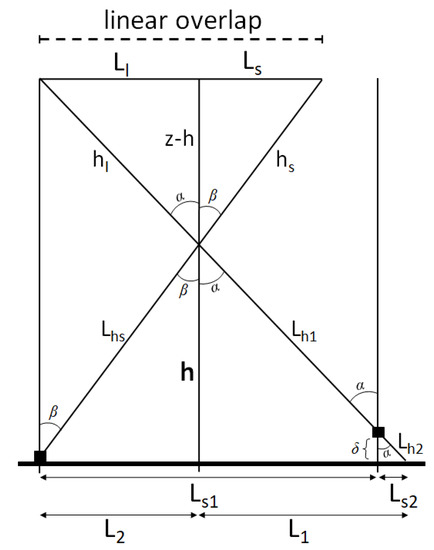
Figure 7.
The geometry used to estimate the superposition region of the horizontal layers sampled by LIDAR and SODAR.
- is the distance between the LIDAR and the SODAR;
- is the scanning cone angle of the LIDAR;
- is the angle of the scanning cone of SODAR;
- is the height of the LIDAR.
As already mentioned, the LIDAR was at a height of = 3.5 m during the campaign but = 0 at the other points ( and ). In the campaign, the horizontal distance between the sensors was 15 m, and in the other two, was 8 m.
From the relations obtained by the triangle formed below the LIDAR (Figure 7), we find :
By substituting from Equation (7) into Equation (6), we find the value of , and thus we find the value of by substituting into Equation (4).
Considering , we have
Now, the height h can be calculated where the linear overlapping of the two sensors started:
The overlap is estimated using
Thus, for both sensors, the linear overlap is given by the sum of the following two terms:
A simple calculation shows that the two sensors would sample, common to both sensors, in a region of the horizontal air layer to the order of 38 m at about 50 m in height, while the linear sum of the sector sampled by both was 108 m. Table 2 lists the extent of the matching horizontal layers sampled by LIDAR and SODAR for all the measurement heights. The percentage of linear overlap started at 35.2% at 50 m and increased to 48% at 280 m.
For the evaluation of this comparison’s results, the differences concerning the layers of the atmosphere (horizontal slab length) sampled by the two sensors had to be considered. The horizontal slab length of the SODAR was 10 m, while for the LIDAR, it was 20 m, and considering the fact that the LIDAR was 3.5 m high in the campaign, the results in a part of the horizontal slab length were not coincident between the sensors and out of the vertical overlap, as illustrated in Figure 6.
The performance of the sensors was estimated based on the lack of information in each sample cell by layer (space), and missing values were not computed in the calculations.
6. Results and Discussions
Both LIDAR and SODAR perform a discard of the captured information through the quality control required by their systems. As a result, its performance can be impaired, presenting failures to obtain data. The comparative analysis indicated high performance by the LIDAR at , with a loss of information to the order of 1%. However, the SODAR showed a loss of sampling efficiency from 1% to 25%, declining more above 170 m ( in Figure 8).
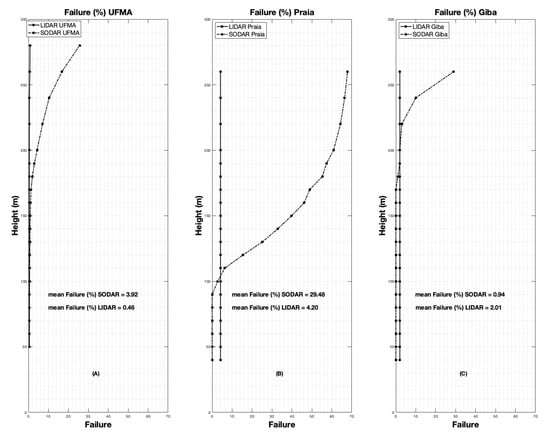
Figure 8.
LIDAR and SODAR performance (% failure) based on height for all three campaigns: (A), (B), and (C). Note that LIDAR was 3.5 m from the surface in the UFMA campaign.
In the campaign, the LIDAR performed well, with only a 4% loss of information. However, the SODAR had poor performance above 100 m in height. At higher heights, the SODAR’s performance decreased significantly, losing about 68% of the information at 260 m in height ( in Figure 8).
The best performance of the comparison between the sensors occurred in the campaign ( in Figure 8). The LIDAR showed a 2% loss at all heights, while the SODAR had no losses until 170 m in height. At heights higher than this, the SODAR had small performance losses, reaching 12% at 260 m.
A decrease in SODAR performance has been reported in other studies. [79] (2021) analyzed about 7 years of data (from 2008 to 2016) at the Ahtopol Meteorological Observatory, about 400 m away from the Black Sea (Bulgaria) at latitude 4252.03″ N. The records were taken every 10 min and filtered by a moving average of 20 min between 30 m and 600 m in height, with a 10-m resolution above 150 m. The equipment was also a SODAR Sintec MFAS with frequencies in the range of 1650–2750 Hz and multi-beam operation of nine emission and reception angles (0, ±9.3, ±15.6, ±22.1, and ±29). The average efficiency data declined above 120 m (10% failure) and reached 20% failure at about 240 m, decreasing to 50% at 250 m.
Even considering the significant difference in latitude and hemisphere, we had considerable similarities in the performance of our SODAR compared to that of [79] (2021), mainly in the place closest to the beach ( in Figure 8).
The average vertical profiles of the horizontal wind speed were calculated by , where u is the zonal component and v is the meridional component. In the campaign, the profiles show the speeds sampled by LIDAR as being slightly higher than those of SODAR from 50 m to about 140 m, and from there, an inversion occurred, with the intensities sampled by SODAR being higher than those of LIDAR ( in Figure 9).
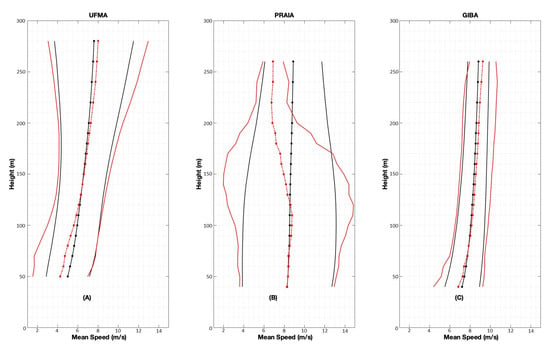
Figure 9.
Mean wind speed profiles of LIDAR (black dotted lines) and SODAR (red dotted lines) obtained in the three campaigns: (A), (B), and (C). The lines represent the variance in the average speed, with LIDAR in black and SODAR in red. Note that the LIDAR was 3.5 m from the surface in the UFMA campaign.
In the coastal region ( campaign), the mean wind speed sampled by SODAR was lower at heights greater than 120 m (Figure 9), which is explained by the decreased performance of this equipment, which had data failures during this campaign, as shown in Figure 8.
These failures can also be observed in Figure 10 when we examine the wind speed plot as a function of height and time. When the wind direction was coming from the ocean, the SODAR signal-to-noise ratio decreased (northeast direction). In this case, the flow suffered less influence from surface roughness effects generating fewer inhomogeneities in the air density field, which were the SODAR targets.
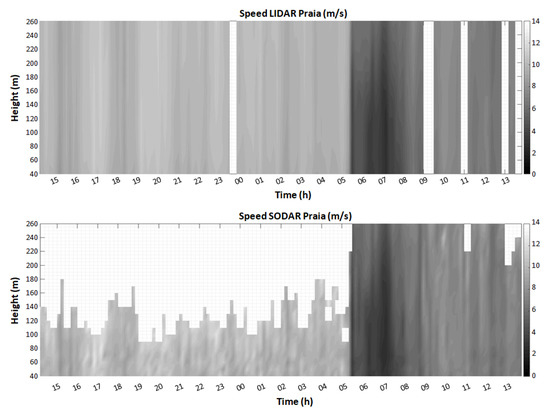
Figure 10.
Wind speed as a function of time and height for the campaign, estimated by LIDAR and SODAR.
Still observing Figure 10, we found that a wind speed greater than 10 ms−1 remained until approximately 5:30 a.m. From this moment, the wind speed abruptly dropped to values below 2 ms−1, and the wind direction changed, coming from the continent (southeast direction). Thus, the SODAR started to record values at heights above 120 m.
For the data sampled in the campaign, the intensity behavior was more homogeneous and more similar to the campaign data ( in Figure 9).
The PCCs, as a function of height, are plotted in Figure 11 for the different campaigns. The curves are separated into zonal in Figure 11A, meridional in Figure 11B, and vertical components in Figure 11C. The zonal and meridional components shows higher PCC values (Figure 11A,B), whereas the vertical component shows somewhat lower values (Figure 11C). The curves generated with the data obtained at are slightly different from the others due to the loss of information from the SODAR at the beginning of the sample period (Figure 10).
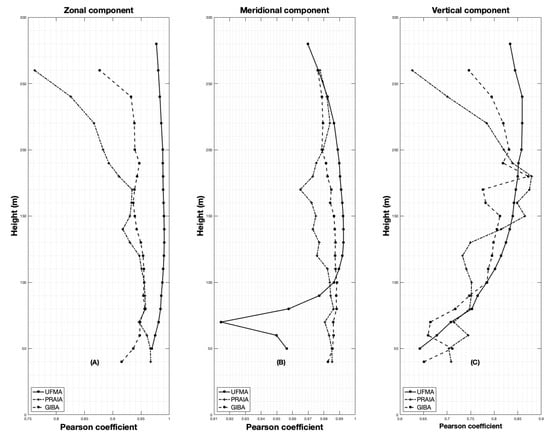
Figure 11.
Pearson’s correlation coefficients (PCCs) between LIDAR and SODAR for the three campaigns: , , and . The panels refer to the correlation of the zonal (east-west) (A), meridional (north-south) (B), and vertical (C) components of the wind speed vector. Note that the LIDAR was 3.5 m from the surface in the UFMA campaign.
Table 3 presents the spatial means of the Pearson’s correlation coefficients (MPCCs) while also considering all vertical levels. In general, the coefficients of the horizontal components were higher than those of the vertical components. The results also indicate higher average coefficients for the campaign (MPCC = 0.93), followed by (MPCC = 0.99) and (MPCC = 0.89).

Table 3.
Means of Pearson’s correlation coefficients (MPCCs) of the zonal, meridional, and vertical wind speed components during the three campaigns—, , and —for all vertical levels.
In Table 4, the MPCCs are presented for the average between the vertical levels from 50 to 150 m, with similar performance for the and campaigns (MPCC = 0.89).

Table 4.
Means of Pearson’s correlation coefficients (MPCCs) of the zonal, meridional, and vertical wind speed components during the three campaigns—, , and —for vertical levels from 50 to 150 m.
In Table 5, the MPCCs are presented for the average between the vertical levels from 150 to 260 m. The results illustrate a lower MPCC in the campaign for all velocity components. The incremental loss of data quality with height in led to a decrease in the PCC in this height interval.

Table 5.
Means of Pearson’s correlation coefficients (MPCCs) of the zonal, meridional, and vertical wind speed components during the three campaigns—, , and —for vertical levels from 150 to 260 m.
7. Summary and Conclusions
In this paper, we had the opportunity to compare two remote sensors to quantify how their estimated parameters agreed or diverged. In addition to this comparison, it was possible to observe the conditions that interfered with the sampling efficiency (i.e., how much each device utilized the collected information). The behavior of the vertical distribution of the mean velocity in the first 100 m showed lower speeds during the campaign due to this campaign being carried out in an urban region, unlike the locations of the and campaigns.
LIDAR performed better concerning the loss of sampling efficiency compared with SODAR over the three campaigns. While the first lost about 1%, 4%, and 2% in the campaigns of , , and , respectively, the second one lost more efficiency at heights above 100 m. In the and campaigns, SODAR lost efficiency from approximately 10 to 30% above 170 m and lost between 65 and 75% above 100 m in the campaign.
Regarding the average vertical profile of the horizontal velocity, both sensors performed similarly in the and campaigns, with SODAR showing higher values above 150 m and 90 m, respectively. In the campaign, above 120 m, it was observed that these values were discrepant, which is explained by the lack of information collected by SODAR, as it only started to record values again after the decrease in the mean speed (<2 ms−1), as shown in Figure 10.
The correlations between the remote sensors for the zonal, meridional, and vertical components obtained using LIDAR and SODAR during the , , and campaigns are listed in Table 3, Table 4 and Table 5. In general, the coefficients of the horizontal components were higher, presenting values greater than 0.9 in all campaigns, while the vertical component obtained values between 0.7 and 0.85.
For the coastal region of Maranhão, by observing the differences between the sensors, and despite the flaws presented, it is concluded that LIDAR and SODAR can be used in the evaluation of meteorological parameters to estimate the wind potential mainly for the conversion of electric energy by wind turbines.
Author Contributions
Conceptualization, A.R.T.J., N.P.S., A.T.A., F.L.A.N., F.M.P., R.M.d.F., O.R.S., C.B.M.O., D.C.P.L., S.L.d.L., R.B.S.V. and D.Q.O.; methodology, A.R.T.J., N.P.S., A.T.A., F.L.A.N., F.M.P., R.M.d.F., O.R.S., C.B.M.O., D.C.P.L., S.L.d.L., R.B.S.V. and D.Q.O.; software, A.R.T.J., N.P.S., D.C.P.L., R.B.S.V. and D.Q.O.; formal analysis, A.R.T.J., N.P.S., A.T.A., F.L.A.N., F.M.P., R.M.d.F. and O.R.S.; investigation, A.R.T.J. and N.P.S.; data curation, A.R.T.J. and N.P.S.; writing—original draft preparation, A.R.T.J., N.P.S., A.T.A., F.L.A.N., F.M.P., R.M.d.F., O.R.S., C.B.M.O., D.C.P.L., S.L.d.L., R.B.S.V. and D.Q.O.; writing—review and editing, A.R.T.J., N.P.S., A.T.A., F.L.A.N., F.M.P., R.M.d.F., O.R.S., C.B.M.O., D.C.P.L., S.L.d.L., R.B.S.V. and D.Q.O.; supervision, D.Q.O. and O.R.S.; project administration, D.Q.O.; funding acquisition, D.Q.O. and O.R.S. All authors have read and agreed to the published version of the manuscript.
Funding
The authors acknowledge funding from Equatorial Energia and Gera Maranhão under the Brazilian Electricity Regulatory Agency’s (ANEEL) R&D Program (PD-00037-0042/2020), the National Council for Scientific and Technological Development of Brazil (CNPq), the Foundation for Support to Research and Scientific and Technological Development of Maranhão (FAPEMA), Coordination for the Improvement of Higher Education Personnel (CAPES), and the National Institute of Science & Technology in Ocean and Fluvial Energies (INEOF).
Institutional Review Board Statement
Not applicable.
Informed Consent Statement
Not applicable.
Data Availability Statement
Not applicable.
Acknowledgments
This study was supported by the Brazilian Electricity Regulatory Agency (ANEEL) under an R&D project (PD-00037-0042/2020) funded by Gera Maranhão S.A. and Equatorial Energia S.A. The authors also acknowledge support from the National Council for Scientific and Technological Development of Brazil (CNPq), the Foundation for Support to Research and Scientific and Technological Development of Maranhão (FAPEMA), Coordination for the Improvement of Higher Education Personnel (CAPES), and the National Institute of Science & Technology in Ocean and Fluvial Energies (INEOF). We are thankful to Gilberto Porto and Dalila Porto for their continuous support and cooperation.
Conflicts of Interest
The authors declare no conflict of interest.
References
- Assireu, A.T.; Pimenta, F.M.; de Freitas, R.M.; Saavedra, O.R.; Neto, F.L.A.; Torres, A.R., Jr.; Oliveira, C.B.M.; Lopes, D.C.P.; de Lima, S.L.; Veras, R.B.S.; et al. EOSOLAR Project: Assessment of wind resources of a coastal equatorial region of Brazil—Overview and preliminary results. Energies 2022, 15, 2319. [Google Scholar] [CrossRef]
- Stickland, M.; Scanlon, T.; Fabre, S. Comparison of Zephir and Windcube measurements in the same complex flowfield. In Proceedings of the EWEA OFFSHORE 2011, Amsterdam, The Netherlands, 29 November–1 December 2011; University of Strathclyde: Glasgow, UK, 2011. [Google Scholar]
- Lang, S.; McKeogh, E. LIDAR and SODAR measurements of wind speed and direction in upland terrain for wind energy purposes. Remote Sens. 2011, 3, 1871–1901. [Google Scholar] [CrossRef]
- Antoniou, I.; Jørgensen, H.E.; Ormel, F.; Bradley, S.; von Hünerbein, S.; Emeis, S.; Warmbier, G. On the Theory of SODAR Measurement Techniques; OCLC: 473721156; Risø National Laboratory, Information Service Department: Roskilde, Denmark, 2003. [Google Scholar]
- Kallistratova, M.A.; Petenko, I.V.; Kouznetsov, R.D.; Kulichkov, S.N.; Chkhetiani, O.G.; Chunchusov, I.P.; Lyulyukin, V.S.; Zaitseva, D.V.; Vazaeva, N.V.; Kuznetsov, D.D.; et al. Sodar sounding of the atmospheric boundary layer: Review of studies at the Obukhov Institute of Atmospheric Physics, Russian Academy of Sciences. Izv. Atmos. Ocean. Phys. 2018, 54, 242–256. [Google Scholar] [CrossRef]
- Kelley, N.D.; Jonkman, B.J.; Scott, G.N.; Pichugina, Y.L. Comparing Pulsed Doppler LIDAR with SODAR and Direct Measurements for Wind Assessment; Technical Report; National Renewable Energy Lab. (NREL): Golden, CO, USA, 2007. [Google Scholar]
- Sotelino, L.G.; Coster, N.D.; Beirinckx, P.; Peeters, P. Intercomparison of Cup Anemometer and Sonic Snemometers on Site at Uccle/Belgium. In Proceedings of the WMO Technical Conference on Meteorological and Environmental Instruments and Methods of Observation (TECO-2012), Brussels, Belgium, 16–18 October 2012; p. 7. [Google Scholar]
- Dubov, D.; Aprahamian, B.; Aprahamian, M. Comparison between conventional wind measurement systems and SODAR systems for remote sensing including examination of real wind data. In Proceedings of the 2017 15th International Conference on Electrical Machines, Drives and Power Systems (ELMA), Sofia, Bulgaria, 1–3 June 2017; IEEE: Piscataway, NJ, USA, 2017; pp. 106–109. [Google Scholar] [CrossRef]
- Finn, A.; Rogers, K.; Rice, F.; Meade, J.; Holland, G.; May, P. A comparison of vertical atmospheric wind profiles obtained from monostatic Sodar and unmanned aerial vehicle–based acoustic tomography. J. Atmos. Ocean. Technol. 2017, 34, 2311–2328. [Google Scholar] [CrossRef]
- Sinha, S.; Regeena, M.L.; Sarma, T.V.C.; Hashiguchi, H.; Tuckley, K.R. Doppler Profile Tracing Using MPCF on MU Radar and Sodar: Performance Analysis. IEEE Geosci. Remote Sens. Lett. 2018, 15, 508–511. [Google Scholar] [CrossRef]
- Buzdugan, L.; Stefan, S. A comparative study of SODAR, LIDAR wind measurements and aircraft derived wind observations. Rom. J. Phys. 2020, 65, 810. [Google Scholar]
- Buzdugan, L.; Bugeac, O.P.; Stefan, S. A comparison of low-level wind profiles from Mode-S EHS data with ground-based remote sensing data. Meteorol. Atmos. Phys. 2021, 133, 1455–1468. [Google Scholar] [CrossRef]
- Zhou, Z.; Bu, Z. Wind measurement comparison of Doppler lidar with wind cup and L band sounding radar. Atmos. Meas. Tech. Discuss. 2021, preprint. [Google Scholar] [CrossRef]
- Aitken, M.L.; Rhodes, M.E.; Lundquist, J.K. Performance of a Wind-Profiling Lidar in the Region of Wind Turbine Rotor Disks. J. Atmos. Ocean. Technol. 2012, 29, 347–355. [Google Scholar] [CrossRef]
- Kumer, V.M.; Reuder, J.; Furevik, B.R. A Comparison of LiDAR and Radiosonde Wind Measurements. Energy Procedia 2014, 53, 214–220. [Google Scholar] [CrossRef]
- Alfredini, P.; Arasaki, E.; Fortner, E. Behavior of sea level in the period of 1980 to 2017 on the port area of Gulf of Maranhão, Brazil. Transnav Int. J. Mar. Navig. Saf. Sea Transp. 2021, 15, 683–686. [Google Scholar] [CrossRef]
- Philander, S.G.H. El Niño Southern Oscillation phenomena. Nature 1983, 302, 295–301. [Google Scholar] [CrossRef]
- Philander, S.; Seigel, A. Chapter 33 Simulation of El Niño of 1982–1983. In Deep Sea Research Part II: Topical Studies in Oceanography; Elsevier: Amsterdam, The Netherlands, 1985; Volume 40, pp. 517–541. [Google Scholar] [CrossRef]
- Philander, S.G.; Rasmusson, E.M. The Southern Oscillation and El Niño. In Advances in Geophysics; Elsevier: Amsterdam, The Netherlands, 1985; Volume 28, pp. 197–215. [Google Scholar] [CrossRef]
- Philander, G. El Niño and La Niña. Am. Sci. 1989, 77, 451–459. [Google Scholar]
- Kane, R.P. Prediction of Droughts in North-East Brazil: Role of ENSO and Use of Periodicities. Int. J. Climatol. 1997, 17, 655–665. [Google Scholar] [CrossRef]
- Goddard, L.; Philander, S.G. The Energetics of El Niño and La Niña. J. Clim. 2000, 13, 1496–1516. [Google Scholar] [CrossRef]
- Grimm, A.M. The El Niño Impact on the Summer Monsoon in Brazil: Regional Processes versus Remote Influences. J. Clim. 2003, 16, 263–280. [Google Scholar] [CrossRef]
- Philander, S.G.; Fedorov, A. Is El Niño Sporadic or Cyclic? Annu. Rev. Earth Planet. Sci. 2003, 31, 579–594. [Google Scholar] [CrossRef]
- Hastenrath, S. Circulation and teleconnection mechanisms of Northeast Brazil droughts. Prog. Oceanogr. 2006, 70, 407–415. [Google Scholar] [CrossRef]
- Philander, S.G. Our Affair with El Nino: How We Transformed an Enchanting Peruvian Current Into a Global Climate Hazard; Princeton University Press: Princeton, NJ, USA, 2006. [Google Scholar]
- Kayano, M.T.; Andreoli, R.V. Relationships between rainfall anomalies over northeastern Brazil and the El Niño–Southern Oscillation. J. Geophys. Res. 2006, 111, D13101. [Google Scholar] [CrossRef]
- Rodrigues, R.R.; Haarsma, R.J.; Campos, E.J.D.; Ambrizzi, T. The Impacts of Inter–El Niño Variability on the Tropical Atlantic and Northeast Brazil Climate. J. Clim. 2011, 24, 3402–3422. [Google Scholar] [CrossRef]
- Cai, W.; McPhaden, M.J.; Grimm, A.M.; Rodrigues, R.R.; Taschetto, A.S.; Garreaud, R.D.; Dewitte, B.; Poveda, G.; Ham, Y.G.; Santoso, A.; et al. Climate impacts of the El Niño–Southern Oscillation on South America. Nat. Rev. Earth Environ. 2020, 1, 215–231. [Google Scholar] [CrossRef]
- Costa, M.d.S.; Oliveira-Júnior, J.F.d.; Santos, P.J.d.; Correia Filho, W.L.F.; Gois, G.d.; Blanco, C.J.C.; Teodoro, P.E.; Silva Junior, C.A.d.; Santiago, D.d.B.; Souza, E.d.O.; et al. Rainfall extremes and drought in Northeast Brazil and its relationship with El Niño–Southern Oscillation. Int. J. Climatol. 2021, 41, 6835. [Google Scholar] [CrossRef]
- Glenn, A.H. Circulation and Convergence in the Equatorial Zone Between 95∘ E and 160∘ E: December to February*. Bull. Am. Meteorol. Soc. 1947, 28, 453–464. [Google Scholar] [CrossRef]
- Simpson, R.H. Synoptic Aspects of the Intertropical Convergence Near Central and South America. Bull. Am. Meteorol. Soc. 1947, 28, 335–346. [Google Scholar] [CrossRef]
- Miles, M.K. Meteorology. Sci. Prog. (1933) 1948, 36, 86–101. [Google Scholar]
- Crowe, P.R. The seasonal variation in the strength of the trades. In Transactions and Papers (Institute of British Geographers); Wiley: Hoboken, NJ, USA, 1950; p. 25. [Google Scholar] [CrossRef]
- Waliser, D.E.; Somerville, R.C.J. Preferred latitudes of the Intertropical Convergence Zone. J. Atmos. Sci. 1994, 51, 1619–1639. [Google Scholar] [CrossRef]
- Philander, S.G.H.; Gu, D.; Lambert, G.; Li, T.; Halpern, D.; Lau, N.C.; Pacanowski, R.C. Why the ITCZ Is Mostly North of the Equator. J. Clim. 1996, 9, 2958–2972. [Google Scholar] [CrossRef]
- Gomes, H.B.; Ambrizzi, T.; Herdies, D.L.; Hodges, K.; Pontes da Silva, B.F. Easterly Wave Disturbances over Northeast Brazil: An Observational Analysis. Adv. Meteorol. 2015, 2015, 176238. [Google Scholar] [CrossRef]
- Waliser, D.; Jiang, X. Tropical meteorology and climate: Intertropical Convergence Zone. In Encyclopedia of Atmospheric Sciences; Elsevier: Amsterdam, The Netherlands, 2015; pp. 121–131. [Google Scholar] [CrossRef]
- Nogués-Paegle, J.; Mechoso, C.R.; Fu, R.; Berbery, E.H.; Chao, W.C.; Chen, T.C.; Cook, K.; Diaz, A.F.; Enfield, D.; Ferreira, R.; et al. Progress in Pan American CLIVAR research: Understanding the South American monsoon. Meteorologica 2002, 27, 1–30. [Google Scholar]
- Gan, M.A.; Kousky, V.E.; Ropelewski, C.F. The South America Monsoon Circulation and Its Relationship to Rainfall over West-Central Brazil. J. Clim. 2004, 17, 47–66. [Google Scholar] [CrossRef]
- Liebmann, B.; Mechoso, C.R. The South American Monsoon System. In World Scientific Series on Asia-Pacific Weather and Climate, 2nd ed.; World Scientific: Singapore, 2011; Volume 5, pp. 137–157. [Google Scholar] [CrossRef]
- Marengo, J.A.; Liebmann, B.; Grimm, A.M.; Misra, V.; Silva Dias, P.L.; Cavalcanti, I.F.A.; Carvalho, L.M.V.; Berbery, E.H.; Ambrizzi, T.; Vera, C.S.; et al. Recent developments on the South American monsoon system: Recent Developments on the South American Monsoon System. Int. J. Climatol. 2012, 32, 1–21. [Google Scholar] [CrossRef]
- Vuille, M.; Burns, S.J.; Taylor, B.L.; Cruz, F.W.; Bird, B.W.; Abbott, M.B.; Kanner, L.C.; Cheng, H.; Novello, V.F. A review of the South American monsoon history as recorded in stable isotopic proxies over the past two millennia. Clim. Past 2012, 8, 1309–1321. [Google Scholar] [CrossRef]
- de Carvalho, L.M.V.; Cavalcanti, I.F.A. The South American Monsoon System (SAMS). In The Monsoons and Climate Change; de Carvalho, L.M.V., Jones, C., Eds.; Springer Climate; Springer International Publishing: Cham, Switzerland, 2016; pp. 121–148. [Google Scholar] [CrossRef]
- Correa, I.C.; Arias, P.A.; Rojas, M. Evaluation of multiple indices of the South American monsoon. Int. J. Climatol. 2021, 41, E2801–E2819. [Google Scholar] [CrossRef]
- Madden, R.A.; Julian, P.R. Detection of a 40–50 Day Oscillation in the Zonal Wind in the Tropical Pacific. J. Atmos. Sci. 1971, 28, 702–708. [Google Scholar] [CrossRef]
- Madden, R.A.; Julian, P.R. Description of Global-Scale Circulation Cells in the Tropics with a 40–50 Day Period. J. Atmos. Sci. 1972, 29, 1109–1123. [Google Scholar] [CrossRef]
- Madden, R.A.; Julian, P.R. Observations of the 40–50-Day Tropical Oscillation—A Review. Mon. Weather. Rev. 1994, 122, 814–837. [Google Scholar] [CrossRef]
- de Souza, E.B.; Ambrizzi, T. Modulation of the intraseasonal rainfall over tropical Brazil by the Madden–Julian oscillation. Int. J. Climatol. 2006, 26, 1759–1776. [Google Scholar] [CrossRef]
- Alvarez, M.S.; Vera, C.S.; Kiladis, G.N.; Liebmann, B. Influence of the Madden Julian Oscillation on precipitation and surface air temperature in South America. Clim. Dyn. 2016, 46, 245–262. [Google Scholar] [CrossRef]
- Mayta, V.C.; Ambrizzi, T.; Espinoza, J.C.; Silva Dias, P.L. The role of the Madden-Julian oscillation on the Amazon Basin intraseasonal rainfall variability. Int. J. Climatol. 2019, 39, 343–360. [Google Scholar] [CrossRef]
- Mayta, V.C.; Silva, N.P.; Ambrizzi, T.; Dias, P.L.S.; Espinoza, J.C. Assessing the skill of all-season diverse Madden–Julian oscillation indices for the intraseasonal Amazon precipitation. Clim. Dyn. 2020, 54, 3729–3749. [Google Scholar] [CrossRef]
- Zhang, C.; Adames, A.F.; Khouider, B.; Wang, B.; Yang, D. Four theories of the Madden-Julian Oscillation. Rev. Geophys. 2020, 58, e2019RG000685. [Google Scholar] [CrossRef]
- Vasconcelos Junior, F.d.C.; Jones, C.; Gandu, A.W.; Martins, E.S.P.R. Impacts of the Madden-Julian Oscillation on the intensity and spatial extent of heavy precipitation events in northern Northeast Brazil. Int. J. Climatol. 2021, 41, 3628–3639. [Google Scholar] [CrossRef]
- Sena, A.C.T.; Peings, Y.; Magnusdottir, G. Effect of the Quasi-Biennial Oscillation on the Madden Julian Oscillation Teleconnections in the Southern Hemisphere. Geophys. Res. Lett. 2022, 49, e2021GL096105. [Google Scholar] [CrossRef]
- Serra, Y.L.; Kiladis, G.N.; Cronin, M.F. Horizontal and Vertical Structure of Easterly Waves in the Pacific ITCZ. J. Atmos. Sci. 2008, 65, 1266–1284. [Google Scholar] [CrossRef]
- Toma, V.E.; Webster, P.J. Oscillations of the Intertropical Convergence Zone and the genesis of easterly waves. Part I: Diagnostics and theory. Clim. Dyn. 2010, 34, 587–604. [Google Scholar] [CrossRef]
- Toma, V.E.; Webster, P.J. Oscillations of the Intertropical Convergence Zone and the genesis of easterly waves Part II: Numerical verification. Clim. Dyn. 2010, 34, 605–613. [Google Scholar] [CrossRef]
- Xie, S.P.; Carton, J.A. Tropical atlantic variability: Patterns, mechanisms, and impacts. In Geophysical Monograph Series; Wang, C., Xie, S., Carton, J., Eds.; American Geophysical Union: Washington, DC, USA, 2013; pp. 121–142. [Google Scholar] [CrossRef]
- Gomes, H.B.; Ambrizzi, T.; Pontes da Silva, B.F.; Hodges, K.; Silva Dias, P.L.; Herdies, D.L.; Silva, M.C.L.; Gomes, H.B. Climatology of easterly wave disturbances over the tropical South Atlantic. Clim. Dyn. 2019, 53, 1393–1411. [Google Scholar] [CrossRef]
- de Medeiros, F.J.; de Oliveira, C.P.; Torres, R.R. Climatic aspects and vertical structure circulation associated with the severe drought in Northeast Brazil (2012–2016). Clim. Dyn. 2020, 55, 2327–2341. [Google Scholar] [CrossRef]
- Roxburgh, W. XLVII. On the land winds of Coromandel, and their causes. The Philosophical Magazine, 1 October 1810; Volume 36, pp. 243–253. [Google Scholar] [CrossRef][Green Version]
- Hall, F. XXIII. Meteorological observations made during a residence in Colombia between the years 1820 and 1830. London Edinburgh Dublin Philos. Mag. J. Sci. 1838, 12, 148–158. [Google Scholar] [CrossRef][Green Version]
- Hopkins, T. LXVIII. On the diurnal change of the aqueous portion of the atmosphere, and their effects on the barometer. London Edinburgh Dublin Philos. Mag. J. Sci. 1845, 27, 427–435. [Google Scholar] [CrossRef]
- Sabine. VIII. On some points in the meteorology of Bombay. London Edinburgh Dublin Philos. Mag. J. Sci. 1846, 28, 24–35. [Google Scholar] [CrossRef]
- Kousky, V.E. Diurnal rainfall variation in northeast Brazil. Mon. Weather. Rev. 1980, 108, 488–498. [Google Scholar] [CrossRef]
- Planchon, O.; Damato, F.; Dubreuil, V.; Gouery, P. A method of identifying and locating sea-breeze fronts in north-eastern Brazil by remote sensing. Meteorol. Appl. 2006, 13, 225. [Google Scholar] [CrossRef]
- Souza, D.C.d.; Oyama, M.D. Breeze potential along the brazilian northern and northeastern coast. J. Aerosp. Technol. Manag. 2017, 9, 368–378. [Google Scholar] [CrossRef]
- Ribeiro, F.N.; Oliveira, A.P.d.; Soares, J.; Miranda, R.M.d.; Barlage, M.; Chen, F. Effect of sea breeze propagation on the urban boundary layer of the metropolitan region of Sao Paulo, Brazil. Atmos. Res. 2018, 214, 174–188. [Google Scholar] [CrossRef]
- Anjos, M.; Lopes, A. Sea breeze front identification on the northeastern coast of Brazil and its implications for meteorological conditions in the Sergipe region. Theor. Appl. Climatol. 2019, 137, 2151–2165. [Google Scholar] [CrossRef]
- Anjos, M.; Lopes, A.; Lucena, A.J.d.; Mendonça, F. Sea breeze front and outdoor thermal comfort during summer in northeastern Brazil. Atmosphere 2020, 11, 1013. [Google Scholar] [CrossRef]
- Wang, L.; Qiang, W.; Xia, H.; Wei, T.; Yuan, J.; Jiang, P. Robust solution for boundary layer height detections with coherent doppler wind lidar. Adv. Atmos. Sci. 2021, 38, 1920–1928. [Google Scholar] [CrossRef]
- LEOSPHERE. Windcube FCR Measurements; LEOSPHERE: Saclay, France, 2017. [Google Scholar]
- ScintecAG. Scintec Flat Array Sodars—Theory Manual (SFAS, MFAS, XFAS) Including RASS RAE1 and WindRASS, Version 1.03 ed; Technical Report; ScintecAG: Princeton, NJ, USA, 2017. [Google Scholar]
- Kelberlau, F.; Mann, J. Cross-contamination effect on turbulence spectra from Doppler beam swinging wind lidar. Wind. Energy Sci. 2020, 5, 519–541. [Google Scholar] [CrossRef]
- Chatfield, C. The Analysis of Time Series: An Introduction, 6th ed.; OCLC: 880737910; Taylor and Francis: Hoboken, NJ, USA, 2013. [Google Scholar]
- Bertrand, C.; González Sotelino, L.; Journée, M. Quality control of the RMI’s AWS wind observations. Adv. Sci. Res. 2016, 13, 13–19. [Google Scholar] [CrossRef]
- Lo Feudo, T.; Calidonna, C.R.; Avolio, E.; Sempreviva, A.M. Study of the vertical structure of the coastal boundary layer integrating surface measurements and ground-based remote sensing. Sensors 2020, 20, 6516. [Google Scholar] [CrossRef] [PubMed]
- Barantiev, D.; Batchvarova, E. Wind speed profile statistics from acoustic soundings at a black sea coastal site. Atmosphere 2021, 12, 1122. [Google Scholar] [CrossRef]
Publisher’s Note: MDPI stays neutral with regard to jurisdictional claims in published maps and institutional affiliations. |
© 2022 by the authors. Licensee MDPI, Basel, Switzerland. This article is an open access article distributed under the terms and conditions of the Creative Commons Attribution (CC BY) license (https://creativecommons.org/licenses/by/4.0/).